|
The thermionic valve was to the electronics revolution what the steam engine had been to the first industrial revolution. Its invention was the key to all the possibilities of wireless communication and other applications of electronics which have proved to be the distinguishing achievement of this (20th) century.
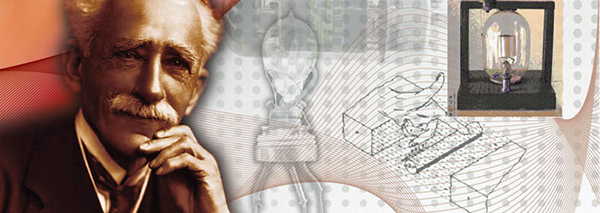
John Ambrose Fleming.
The first radio valve was created in 1904, when J A Fleming, working for the Marconi company, took an old Edison lightbulb from a cupboard and reran an 1882 experiment. This resulted in his 'oscillation valve', or diode.
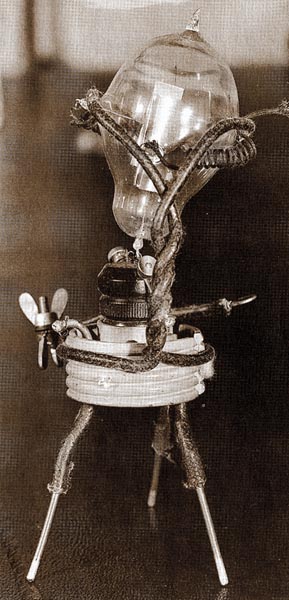
An early Fleming Diode.
In itself, the diode was a less practical tool than Marconi's existing magnetic detector, introduced in 1902 to replace the coherer and used in ship and shore installations until 1918.
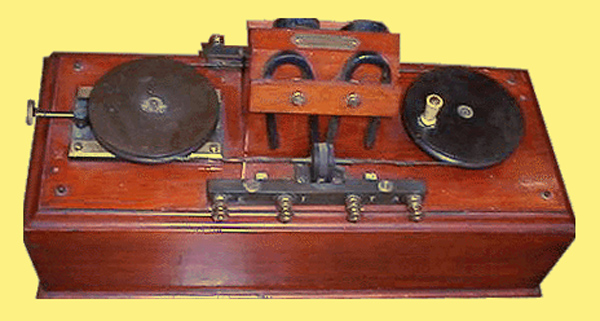
Marconi's magnetic detector, introduced in 1902 and the predecessor to the valve.
The 'Maggie' comprised a continuous band of soft iron wires, turned by a clockwork motor, and passed through a glass tube. On the tube was wound an RF transformer, connected to the aerial and earth, and a telephone earpiece. Magnetisation was induced in the wires by a pair of stationary magnets, but subjected to distortion (hysteresis) by the motion of the wires. A high frequency signal would overcome this and produce an audible click. The 'Maggie' increased traffic flow to 30 words per minute.
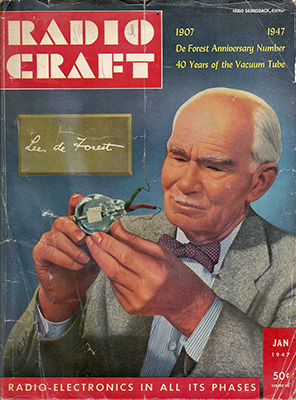
Lee de Forest.
Flemings diode was swiftly superseded by a 1906 American breakthrough, Lee de Forests triode. This incorporated a third electrode which permitted the development of the valve as an amplifier.
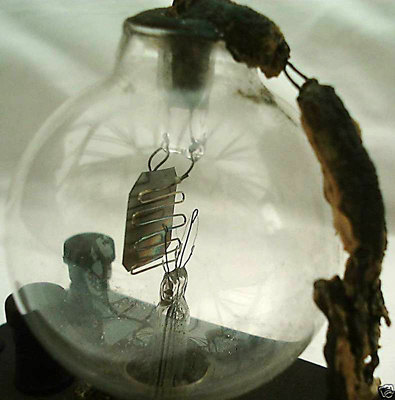
An early production Audion.
The outbreak of the first World War had a galvanic effect on wireless, driving forward developments in many fields. But nowhere did the pressure of military requirements produce more dramatic results than in the evolution of the valve. These entered the war scarcely past the experimental stage - hand-built, delicate and unreliable in performance.
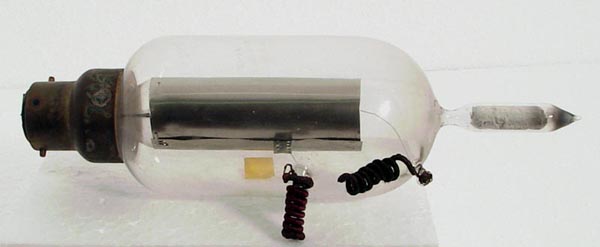
Round Type N 'soft valve'. The pre-war Round valve, named after its inventor, Capt H J Round, was a 'soft' valve containing residual gases. To activate the valve the long 'beak', which contained a small of spongy platinum, had tube warmed with a match flame to liberate gases and bring the valve to the necessary degree of softness.
They were 'soft' valves, incompletely evacuated, with residual gases affecting their function. By the end of the war, the 'hard valve had emerged, highly-evacuated, robust, consistent in performance and relatively easy to mass-produce. Developed by Langmuir in the USA, they were manufactured by the military authorities in France, and became known as the 'French' valve.
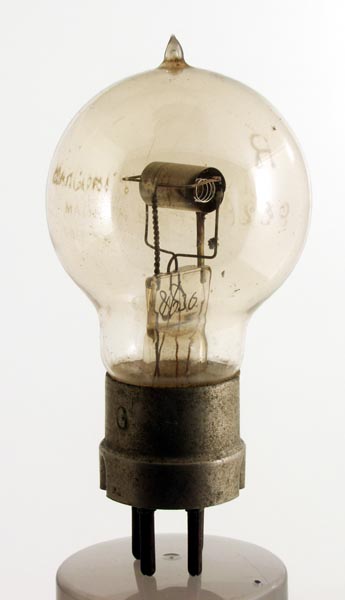
R Type 'hard' valve, made by Marconi.
The Type R triode valve was the English version of the French Type TM, a most successful practical triode designed in 1915 under pressure of war by the French Military Telegraph Service, directed by General Ferrie.
First the weaknesses of De Forests Audion were analysed. Then they evolved a fine design for a simple, robust, easy to manufacture, general purpose hard triode which was put quickly into large-scale production in France.
In 1916 the British authorities ordered this design (and many variants) to be made by five UK valve and lamp manufacturers.
Audio and CW field sets were quickly designed by the French around the valve and the British later used it in their trench sets and RAF equipment. Even the Americans used the TM on their arrival in France in 1917. TM valves were used in French multi-valve amplifiers where the valves, being of close tolerance, were interchangeable. After the war amateurs used the valve despite its 2.8 W bright-emitter filament, which gave almost as much illumination as entertainment. The valve was available via post-war Government disposals or could be purchased new for 15 shillings in the twenties.
So the R valve was the first practical 'modem valve. Its design was copied for some time and the four-pin base it carried was to become the European standard for many years.
Typical R valve parameters were: gm = 0.33mA/V; μ = 10; ra = 30kΩ; Va = 70- 400. Some microphony did occur.
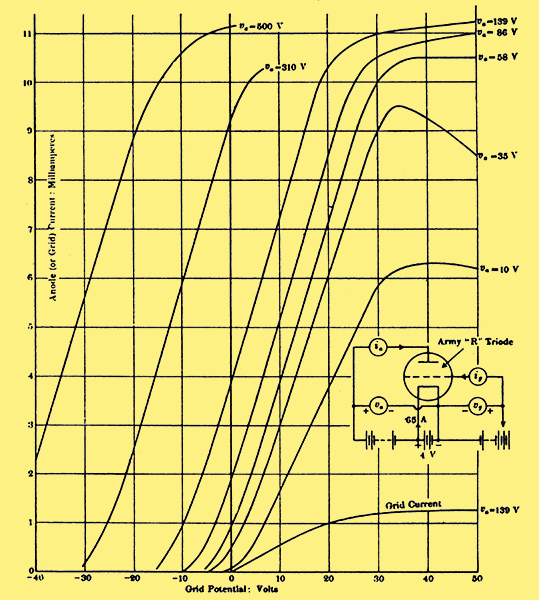
Ia/Vg characteristics of the type R triode.
Consider now a transmitting valve designed five years after the TM - the Marconi Type MT3. This small transmitting valve was the work of Captain Round as part of his remarkable programme of air-cooled glass transmitting valves, Marconi types MT1 to MT5, developed between 1920 and 1922. Marconi post-war transmitters were designed round these valves.
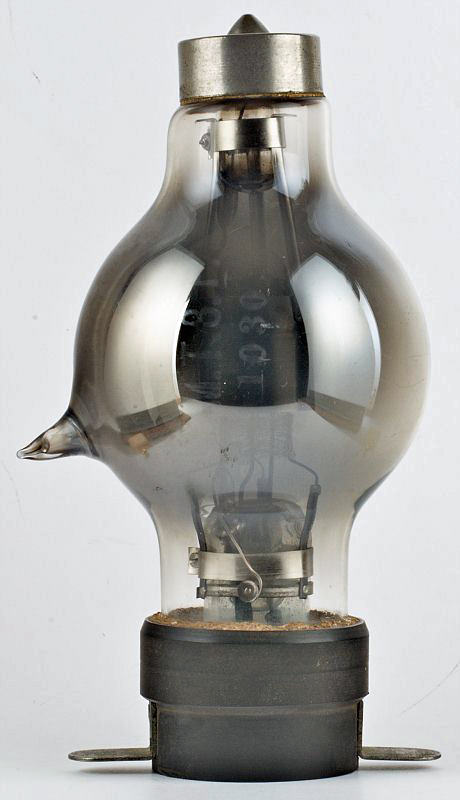
Marconi's MT3 designed by Round, and used in transmitters and aircraft sets.
The MT3, for example, was used for several of their post-war aircraft sets eg type AD1 Transmitter and type AD2 airborne telephone/telegraph transmitter/receiver. (The latter, a compact set in a wooden case, used one MT3 as power oscillator and the second as speech control valve. Its receiver used valves types Q and V24. Total weight of the set was 63lb). The MT3 valve was also used in Marconi field portable 100 W transmitters type YB1.
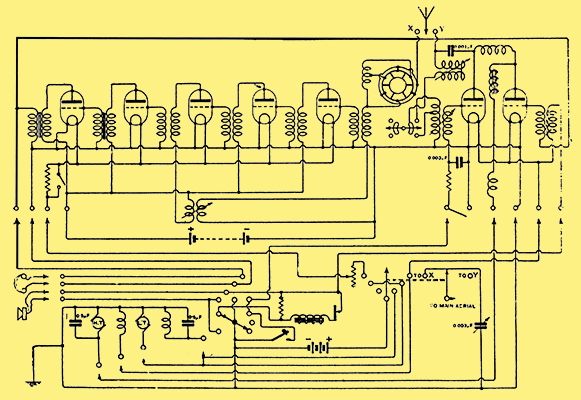
Marconi AD2 aircraft radio-telephone transmitter/receiver c. 1924 using MT3 valves as oscillator and speech control valves.
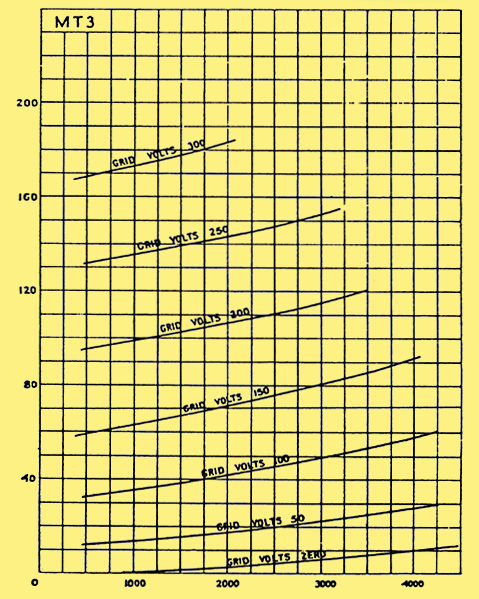
Ia/Vg characteristics of the MT3 for various values of Vg.
MT3 parameters: 80W output on LW telegraphy; 40W max dissipation on CW; μ = 100; ra = 300kΩ; Va = 1,500. This valve type was still available for replacements in the mid-thirties.
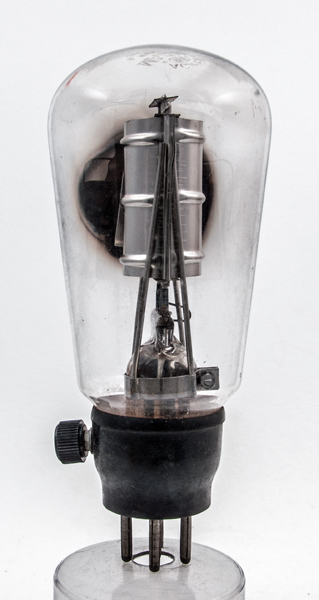
The Mazda AC/Pen.
The third valve in this selection, the Mazda AC/Pen, followed Philips introduction of the pentode in Holland in 1927. This was a most significant step in valve development - the pentode, in directly-heated form, was the universal valve for receiver output stages to drive loud-speakers.
The Mazda AC/Pen was the worlds first successful indirectly- heated pentode. It appeared in May 1930, some three years after the Philips valve. The AC/Pen originated from the same stable as the earlier notable Cosmos short path series of IH valves, but was sold under the Mazda label.
This very successful valve had a mutual conductance of 2.2, claiming to be the most sensitive pentode and to operate without hum. It demonstrated the great advance made in valve design and manufacturing technique by 1930, with its intricate assembly of five electrodes, delicate heater and supports all held rigidly within a standard envelope.
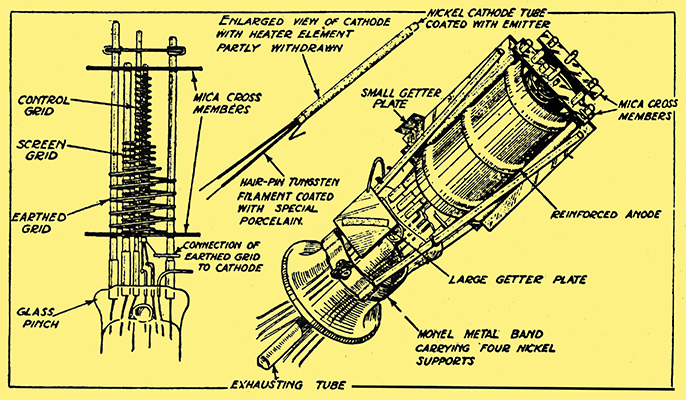
The amount of manufacturing skill needed in 1930 to build the AC/Pen IH pentode was considerable - as this sketch shows.
Amplifying with 10V negative bias, with Va = 250 and Vg2 = 200, the AC/Pen delivered 1.5W undistorted energy when working into a 7,500Ω load. So successful was the design that it became the basis of later Mazda valves, such as the high-sensitivity pentode, AC/2Pen, of 1934. AC/Pen values: gm = 2.2mA/V; ra = 33k; u = 50 @ 150V; Max dissipation 8W.
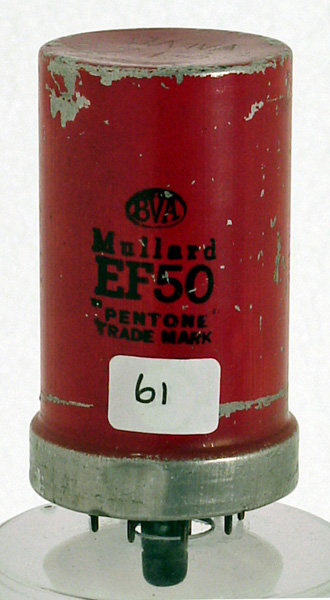
Our next valve - the first all-glass tube by Philips-Mullard - was announced early in 1939. The times were threatening but this tube, the Type EF50, was to be a most valuable tool in the battles to come.
With a mutual conductance of 6.5mA/V - then an outstandingly high figure - the EF50 was meant for use as a wideband television amplifier, but it was quickly seized on by the back-room boys for a 45MHz IF strip then being produced by Pye for incorporation in 200MHz receivers for the earliest airborne radars. Its ra was 1MΩ; equivalent noise resistance 1,400Ω and reverse transfer capacitance (cold) 0.007 pF; Va = 250.
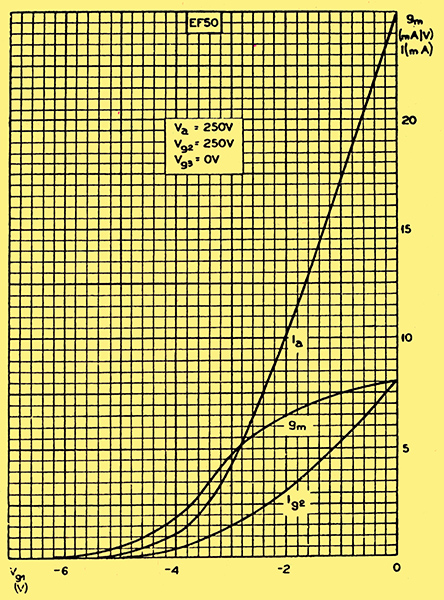
Characteristic curves for the EF50.
In radar receiver applications the EF50 soon gave way to Mullards type RL7, an aligned-grid, low-noise pentode derived from the EF50.
Nevertheless the EF50 was to play so great a part in British wartime equipment that Sylvania (USA) had to be called on to augment supplies of EF5Os to the UK. After the war the EF50 was still in great demand and was also the basis of the type EF55 RF pentode and other tubes.
The popular series of seven-pin B7G 6.3V miniature valves introduced into the UK by Marconi-Osram in 1947 makes a suitable point at which to end this short review. The Z77 (CV138) short-base RF pentode (6.3V IH) typifies this range of compact general purpose receiving valves.
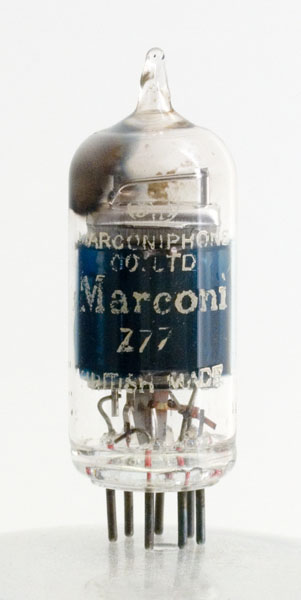
The Z77 also known as EF91 and CV138.
Their 55 mm length, 19 mm diameter and all-glass construction enabled post-war valved radio sets to be much smaller than pre-war sets and their electrode construction and pressed glass bases with direct lead through gave an input capacitance (for the Z77 cold) of 7.4pF. Connected as a pentode with Va = 250V the Z77 had gm = 7.5mA/V and ra = 300kΩ. Rigid electrodes made microphony virtually nil.
|